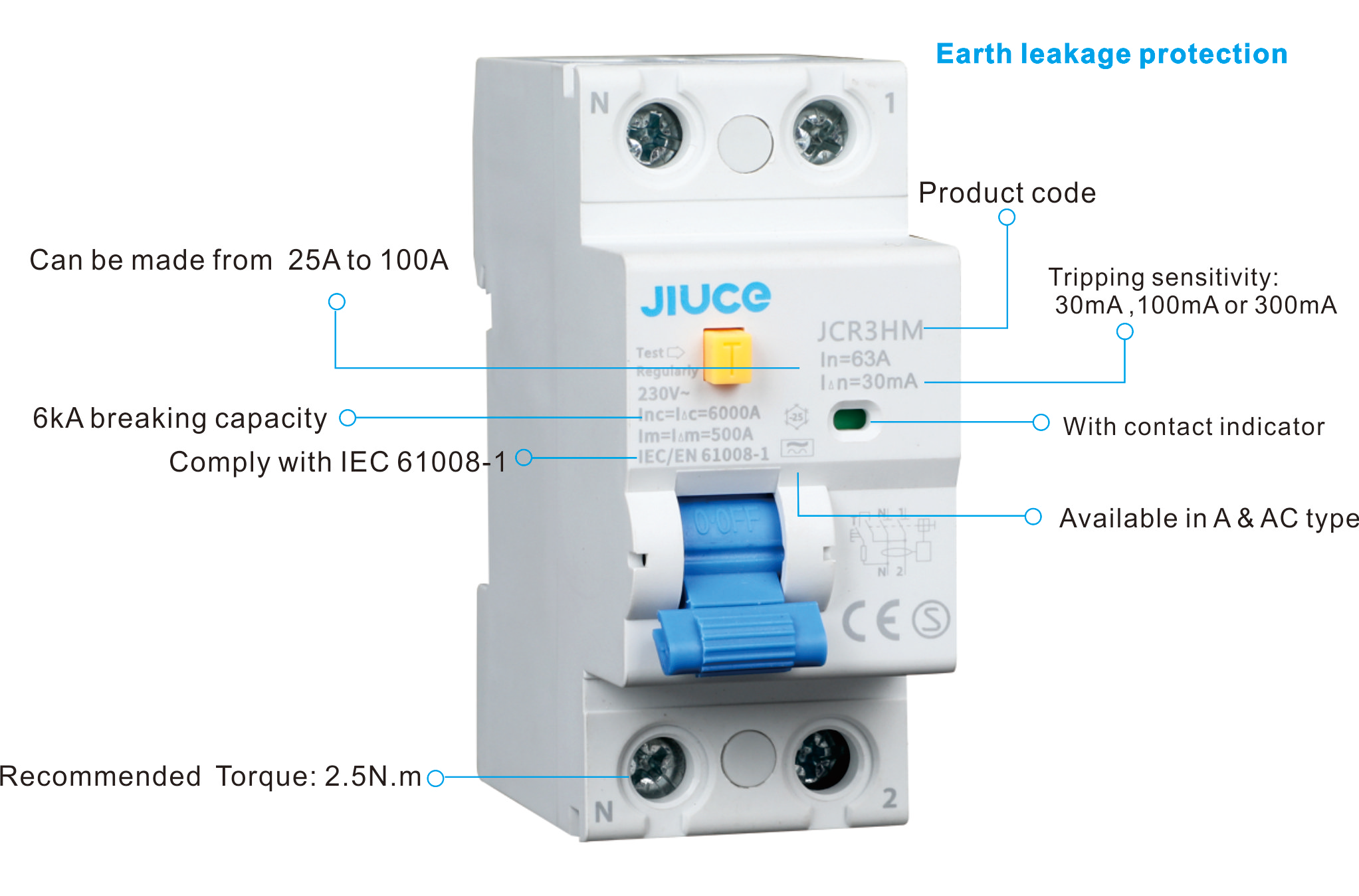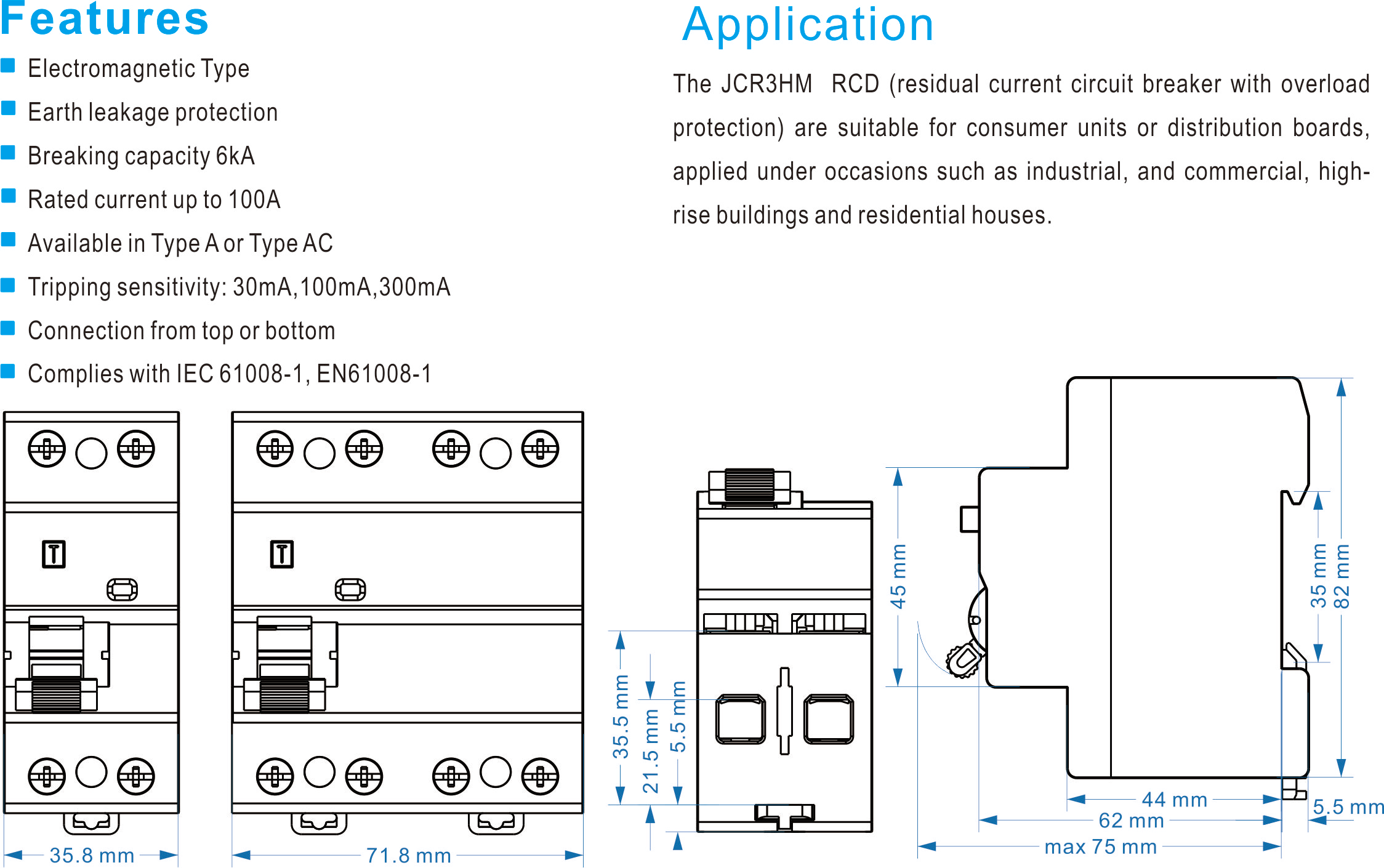JCR3HM 2P 4P Residual current device
JCR3HM residual current device(rcd), is a life-saving device which is designed to prevent you from getting a fatal electric shock if you touch something live, such as a bare wire. It can also provide some protection against electrical fires. Our JCR3HM RCDs offer a level of personal protection that ordinary fuses and circuit-breakers cannot provide. They are suitable for Industrial, Commercial and Domestic Applications
Benefits of JCR3HM RCCB
1.Provides protection against earth fault as well as any leakage current
2.Automatically disconnects the circuit when the rated sensitivity is exceeded
3.Offers possibility of dual termination both for cable and busbar connections
4.Offers protection against voltage fluctuation as it includes a filtering device that guards against transient voltage levels.
Introduction:
JCR3HM Residual current devices (RCDs) are designed to react quickly to any abnormal electrical activity and interrupt the current to prevent dangerous electric shock. These devices are critical to protecting commercial and residential electrical systems.
JCR3HM Residual Current Circuit breaker RCCBs are the safest device to detect and trip against electrical leakage currents, thus ensuring protection against electric shock caused by indirect contacts. These devices must be used in series with an MCB or fuse which protects them from the potentially damaging thermal and dynamic stresses of any over currents. They also act as the main disconnecting switches upstream of any derived MCBs (e.g. domestic consumer unit).
JCR3HM RCCB is an electrical safety device that cuts off the electricity supply immediately upon detecting leakages that may result in an electric shock.
The main function of our JCR3HM RCD is to monitor electrical current and detect any anomalies that may pose a risk to human safety. When a defect in an appliance is detected, the RCD reacts to the surge and immediately interrupts the current flow. This rapid response is critical to preventing potentially life-threatening electrical accidents.
JCR3HM RCD is a sensitive safety device that switches off electricity automatically if there is a fault. In a domestic environment, RCDs provide an extra layer of protection against electrical hazards. With the increasing use of appliances and devices in modern homes, the risk of electrical accidents increases. RCDs continuously monitor the flow of electricity and act as a safety net, giving homeowners and tenants peace of mind.
The JCR3HM RCD is designed to meet high safety standards and provides reliable protection against electric shock. Its advanced technology and precision make it an important component of electrical safety systems. The JCR3HM RCD quickly detects and responds to abnormal electrical activity, providing a level of protection unmatched by traditional circuit breakers and fuses.
2 Pole JCR3HM RCCB is used in case of a single-phase supply connection that has only a live and a neutral wire.
4 Pole JCR3HM RCD is is used in case of a three-phase supply connection.

The most important features
● Electromagnetic type
● Earth leakage protection
● Breaking capacity up to 6kA
● Rated current up to 100A (available in 25A, 32A, 40A, 63A, 80A,100A)
● Tripping sensitivity: 30mA100mA, 300mA
● Type A or Type AC are available
● Positive Status Indication Contact
● 35mm DIN rail mounting
● Installation flexibility with the choice of line connection either from top or bottom
● Complies with IEC 61008-1,EN61008-1
Technical Data
● Standard: IEC 61008-1,EN61008-1
● Type: Electromagnetic
● Type (wave form of the earth leakage sensed): A or AC are available
● Poles: 2 pole, 1P+N, 4 pole, 3P+N
● Rated current: 25A, 40A, 63A, 80A,100A
● Rated working voltage: 110V, 230V, 240V (1P + N); 400v, 415V (3P+N)
● Rated sensitivity ln: 30mA. 100mA 300mA
● Rated breaking capacity: 6kA
● Insulation voltage: 500V
● Rated frequency: 50/60Hz
● Rated impulse withstand voltage (1.2/50) :6kV
● Pollution degree:2
● Mechanical life: 2000 times
● Electrical life: 2000 times
● Protection degree: IP20
● Ambient temperature (with daily average s35°C): -5C+40C
● Contact position indicator: Green=OFF Red=ON
● Terminal connection type: Cable/Pin-type busbar
● Mounting: On DIN rail EN 60715 ( 35mm) by means of fast clip device
● Recommended torque: 2.5N.m
● Connection: From top or bottom are available

What is a RCD?
This electrical device is specifically constructed to switch off the flow of electrical current whenever a ground leak is detected at a significant level that can be dangerous to humans. RCDs are able to switch the current flow within 10 to 50 milliseconds of detecting a prospective leak.
Each RCD will work to constantly monitor the electrical current flowing through one or more circuits. It actively focuses on measuring the live and neutral wires. When it detects that the electrical current flowing through both wires is not the same, the RCD will turn the circuit off. This indicates that the electrical current has an unintended path that is potentially dangerous, such as a person touching a live wire or an appliance that is acting faulty.
In most residential settings, these protection devices are used in wet rooms and for all appliances to keep homeowners safe. They’re also ideal for keeping commercial and industrial equipment safe from electrical overload that could potentially damage or even start an unwanted electrical fire.
How Do You Test RCDs?
The integrity of an RCD should be tested on a regular basis. All sockets and fixed RCD should be tested about every three months. Portable units should be tested each time you use them. Testing helps to ensure that your RCDs are working efficiently and will protect you from any potential electrical hazards.
The process of testing an RCD is fairly straightforward. You want to hit the test button on the front of the device. When you release it, the button should disconnect the energy current from the circuit.
Hitting the button simply stimulates the earth’s leakage fault. To turn the circuit back on, you’ll need to turn the on/off switch back to the on position. If the circuit doesn’t turn off, then there’s an issue with your RCD. It’s best to consult a licensed electrician before using the circuit or appliance again.
How to connect the RCD – INSTALLATION DIAGRAM?
The connection of a residual-current device is relatively simple, but a few rules must be followed. An RCD must not be used as a single element between the power source and the load. It does not protect against short circuit or overheating of the wires. For more safety, a combination of RCD and overcurrent circuit breaker, at least one for each RCD, is recommended.
Connect the phase (brown) and neutral (blue) wires to the RCD input in a single-phase circuit. The protective conductor is connected with e.g. a terminal strip.
The phase wire at the RCD output should be connected to the overcurrent circuit breaker, while the neutral wire can be connected directly to the installation.

 Zhejiang Jiuce Intelligent electric co., ltd.
Zhejiang Jiuce Intelligent electric co., ltd.






















